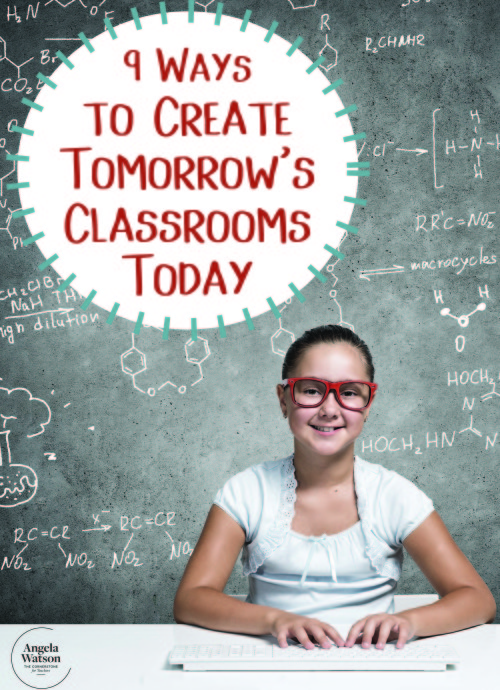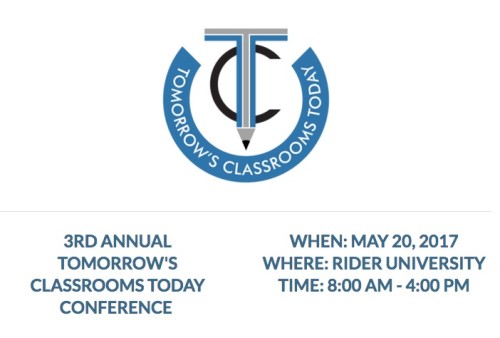On Saturday, May 20th, 2017, I’ll be giving the keynote address at #TCT17, the third annual “Tomorrow’s Classrooms Today” conference. It’s an intense one-day conference packed with a variety of sessions facilitated by educators from across the country.
Since its inception, TCT’s developers have pursued the goal of connecting educators and technology to enhance and energize classrooms. But it’s not just about technology! This year, conference attendees can participate in sessions with topics ranging from teacher blogging to kinesthetic learning.
The TCT website shares nine characteristics that educators should strive to instill in their students. These traits are woven into all aspects of Tomorrow’s Classrooms Today. In this post, I’ll share some practical ways teachers can foster these attributes in their classrooms. Hopefully, you’ll be inspired to transform your own classroom — and to learn more about TCT! 
1. Foster autonomy
An autonomous classroom allows students to make choices about what and how they learn. A strong sense of autonomy is known to motivate students and help them develop self-confidence. Yet many teachers feel stymied when they think about how they can implement a “free-form” instructional style into a rigorous and highly structured curriculum. One solution is to start small. Allow students to choose group members, seating arrangements, assignment due dates, etc. With autonomy comes responsibility, so hold students accountable for the results of their choices. Here’s a great article from Educational Psychology that discusses three different aspects of autonomy and suggests ways teachers can support student autonomy.
2. Encourage risk-taking
Students want to succeed, but adults know that hard-earned success means stepping beyond “safe” boundaries. Growth mindset research shows that our brains change and develop much more when we take on new and challenging tasks. But teachers also know that getting kids to take risks first requires helping them overcome fears. One way to do this is by modeling as you venture out of your own comfort zone. This article on creating a safe space for students to take academic risks gives some excellent ways for teachers to help students become risk takers.
3. Embrace failure
Taking risks and accepting challenges often means coming face to face with failure. It’s tough for adults to bounce back from a fiasco; how do we support our students when it happens to them? Can we teach resilience? Fortunately, there are some environments where failure is expected. Game-playing is one such realm. This article describes using computer-based games and apps to help students deal with failure, and the suggestions readily apply to board and card games, games of chance, and other competitive endeavors.
4. Permit tinkering
Your classroom doesn’t have to be a fully-equipped STEM lab for students to tinker with materials. Here are a ton of imaginative ways to let students have hands-on, open-ended experiences without too much expense or stress.
5. Provide real-world application
Students, and teachers, benefit on so many levels when instruction moves beyond the textbook. Students get the chance to see that what they’re learning has practical, everyday use, and teachers can help them make valuable and long-lasting connections between instruction and authentic experiences. Teachhub.com offers some ways for teachers of all content areas and grade levels to bring the real world into their classrooms.
6. Teach and reinforce patience
With so much access to technology, today’s students (and adults!) have immediate access to almost anything. This short path to instant gratification has certainly impacted our ability to be patient – with ourselves, with the situations we encounter, and with others. But students need patience to help them develop persistence, perseverance, and tolerance for challenging tasks and circumstances. Teaching students to be patient has to start with a teacher who consistently models that same quality. There are many students diagnosed with ADHD who, without chemical intervention, seem incapable of a calm, measured, patient approach to schoolwork. This post, directed at working with that particular population, contains practical strategies for helping all students learn to focus and thrive.
7. Model a caring attitude (empathy/equity/diversity)
Today’s classrooms – and workplaces — are more diverse than ever, and we need to ensure students see a wide representation of that in our instruction. It’s imperative for educators to create environments where differences are expected, accepted, and embraced. We need to examine our own biases to ensure that what we’re modeling for students is truly inclusive and culturally responsive. Teaching Tolerance has some great thoughts on how to build anti-bias into the classroom culture.
8. Embed technology integration
Technology is not just one more thing to add to the curriculum; it’s best used to enhance and deepen student learning. TCT’s founders aim to move beyond “technology for technology’s sake” and help teachers connect with one another to share resources, thoughts, challenges, and transformational ideas. Whether your classroom has an iPad for every student or you’re connecting your personal device to a projector, you can maximize how you use technology to bring the world to your students. Here’s a post from Education World with a list of nearly 20 ways to do this, with links to suggested sites and resources.
9. Support collaboration
Classroom-level collaboration can range from students occasionally working with partners on standards-based activities, to an entire class designing, implementing, and monitoring their self-selected projects — with lots of scenarios in between! Depending on your comfort level, there are resources available to tweak or transform a teacher-centered classroom into one that facilitates and supports student-led instruction. Here’s help for those just exploring what it truly means to be a collaborative classroom and some great tips from Edutopia that allow you to see it in action.  The information above is just the tip of the iceberg! #TCT17 will give attendees the chance to hear from peers who actively and wholeheartedly embrace the mission of Tomorrow’s Classrooms Today. If you’re interested in “committing to changing learning environments that meet students where they are and arming them with an arsenal of skills,” I hope you’ll consider registering for TCT17 and attending my keynote presentation.
The information above is just the tip of the iceberg! #TCT17 will give attendees the chance to hear from peers who actively and wholeheartedly embrace the mission of Tomorrow’s Classrooms Today. If you’re interested in “committing to changing learning environments that meet students where they are and arming them with an arsenal of skills,” I hope you’ll consider registering for TCT17 and attending my keynote presentation.
Speaking of collaboration: TCT’s founders don’t just recommend it, they engage in it through #SatChat! This is a weekly Twitter conversation for current and emerging school leaders that takes place every Saturday morning at 7:30 EST.
Co-founders and co-moderators are Brad Currie, Scott Rocco, and Billy Krakower. #Satchat’s mission is to expand educators’ Personal Learning Network (PLNs) that in turn will promote the success of all students. The chats are spirited discussions among educators from all over the country. Topics are timely, provocative, and of great interest to teachers. Recent conversations have addressed questions like, Is homework still relevant? and How do we get students fully engaged in academic tasks?
Transcript archives of past chats can be found here, including a #satchat I guest moderated on 1/28/17 about being intentional with instructional time.

Angela Watson
Founder and Writer
OR

Join our
community
of educators
If you are a teacher who is interested in contributing to the Truth for Teachers website, please click here for more information.















